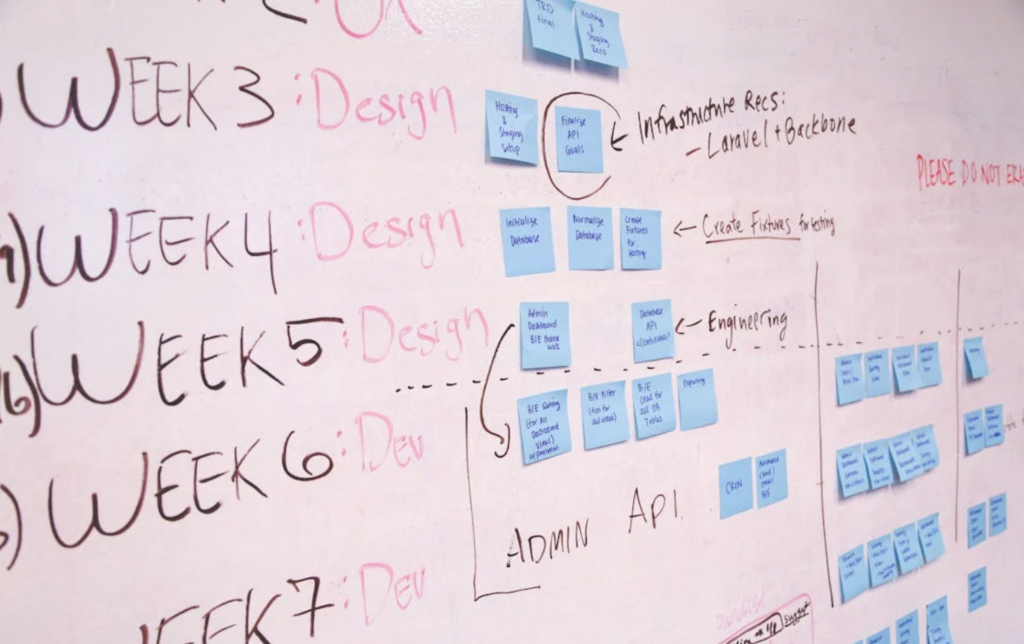From Concept to Launch: How to Manage Web Development Projects Efficiently
Embarking on a web development project can feel like navigating uncharted waters, where effective management of each phase is crucial to success. This guide provides a clear, step-by-step roadmap, detailing essential steps and best practices from initial planning and requirement gathering to final testing and deployment.
You’ll also discover valuable tools and practices to streamline your project management process and ensure a smooth journey.
Key stages in web development projects
1. Project initiation and planning
1.1 Defining the project scope
The first step in any web development project is to clearly define its scope. This involves identifying the project’s objectives, deliverables, features, functions, and tasks. A well-defined scope helps prevent feature creep and ensures that all stakeholders have a clear understanding of what the project entails. These are the main steps:
- Conduct stakeholder interviews to gather requirements
- Create a project charter outlining the project’s purpose and high-level objectives
- Develop a scope statement that clearly defines what is and isn’t included in the project

1.2 Establishing project goals and objectives
With the scope defined, it’s time to set specific, measurable, achievable, relevant, and time-bound (SMART) goals for the project. These goals will serve as guideposts throughout the development process and help you measure the project’s success. These are the main steps:
- Identify KPIs for the project
- Set both short-term and long-term objectives
- Align project goals with overall business objectives
1.3 Creating a detailed project plan
A comprehensive project plan is your roadmap to success. It should outline all the tasks, timelines, resources, and dependencies involved in the project. These are the main steps:
- Break down the project into smaller, manageable tasks
- Estimate the time and resources required for each task
- Create a project timeline or Gantt chart
- Identify critical path tasks and potential bottlenecks
1.4 Assembling the project team
Choosing the right team members is crucial for project success. Consider the skills required for the project and assemble a diverse team that can handle all aspects of web development. Here, you’ll need to:
- Define roles and responsibilities for each team member
- Ensure a good mix of technical and soft skills within the team
- Consider both in-house resources and outsourcing options
1.5 Choosing the right project management methodology
Select a project management methodology that suits your team and project requirements. Common methodologies in web development include Agile, Scrum, Kanban, and Waterfall. Then, follow these steps:
- Assess the pros and cons of different methodologies
- Consider your team’s familiarity with various approaches
- Choose a methodology that aligns with your project’s goals and constraints
When you have decided on methodology, it is important to choose the appropriate project management tool for it. Gantt charts work well for all of the methodologies described above. We can recommend to you a very simple Gantt chart creator – GanttPRO.
2. Requirement gathering and analysis
2.1 Conducting thorough stakeholder interviews
Engage with all relevant stakeholders to gather detailed requirements for the web project. This includes clients, end-users, and internal team members. Along this process:
- Prepare a comprehensive list of questions to cover all aspects of the project
- Use techniques like brainstorming and mind mapping to explore ideas
- Document all requirements and get stakeholder sign-off
2.2 Creating user personas and user stories
Develop user personas to represent your target audience and create user stories to capture the functionality from the user’s perspective.
- Research your target audience to create accurate personas
- Write user stories in the format: “As a [user type], I want [action] so that [benefit]”
- Prioritize user stories based on importance and complexity

2.3 Developing functional and technical specifications
Translate user requirements into detailed functional and technical specifications that will guide the development process. These are the main steps for this:
- Create wireframes and mockups to visualize the user interface
- Document all features and functionalities in detail
- Specify technical requirements, including platforms, languages, and frameworks
2.4 Conducting a feasibility study
Assess the technical, operational, and financial feasibility of the project to ensure it’s viable and aligns with business objectives. This will include the following actions:
- Evaluate the technical challenges and potential solutions
- Assess the project’s alignment with existing systems and processes
- Conduct a cost-benefit analysis to ensure the project is financially sound
3. Design and prototyping
3.1 Creating a design brief
Develop a design brief that outlines the visual direction of the website, including color schemes, typography, and overall aesthetic. Additionally:
- Collaborate with stakeholders to define the brand identity and design preferences
- Research current design trends and best practices in web design
- Create mood boards to visualize the design direction
3.2 Developing wireframes and mockups
Create low-fidelity wireframes to map out the structure and layout of key pages, followed by high-fidelity mockups that showcase the final design.
- Use tools like Sketch, Figma, or Adobe XD for creating wireframes and mockups
- Iterate on designs based on stakeholder feedback
- Ensure designs are responsive and work across different devices
3.3 Building interactive prototypes
Develop interactive prototypes to simulate the user experience and gather feedback before moving into full-scale development. In this case, you will need to:
- Use prototyping tools like InVision or Adobe XD to create interactive demos
- Conduct user testing with the prototypes to identify usability issues
- Refine the design based on user feedback and testing results
4. Development and coding

4.1 Setting up the development environment
Prepare the development environment, including version control systems, development servers, and necessary tools and frameworks. Follow these steps:
- Choose appropriate development tools and frameworks
- Set up version control using Git or similar systems
- Configure development, staging, and production environments
4.2 Implementing front-end development
Begin with front-end development, focusing on creating the user interface and client-side functionality. This may require to:
- Use modern front-end frameworks like React, Vue, or Angular if appropriate
- Implement responsive design principles for cross-device compatibility
- Optimize for performance, considering factors like page load speed
4.3 Developing back-end functionality
Build the server-side components, including databases, APIs, and business logic. This covers the following key steps:
- Choose appropriate back-end technologies (e.g., Node.js, Python, PHP)
- Implement database design and management
- Develop and document APIs for front-end integration
4.4 Integrating third-party services
Incorporate any necessary third-party services or APIs, such as payment gateways, social media integrations, or analytics tools. This breaks down into the following phases:
- Research and select appropriate third-party services
- Implement secure authentication and data handling
- Test integrations thoroughly to ensure reliability
4.5 Implementing Content Management System (CMS)
If required, set up a content management system to allow easy updates and maintenance of the website content. The workflow in this case involves the following actions:
- Choose an appropriate CMS based on project requirements
- Customize the CMS to match the specific needs of the project
- Train content managers on how to use the CMS effectively
5. Quality assurance and testing
5.1 Developing a comprehensive testing strategy
Create a testing plan that covers all aspects of the website, including functionality, usability, performance, and security. This covers the following key steps:
- Define test cases for each feature and user story
- Determine which types of testing are necessary (e.g., unit testing, integration testing, user acceptance testing)
- Establish testing environments that mimic production conditions
5.2 Conducting thorough testing
Execute the testing plan, identifying and documenting any bugs or issues. While doing this:
- Perform functional testing to ensure all features work as expected
- Conduct cross-browser and cross-device testing
- Carry out performance testing to identify bottlenecks and optimize speed
- Implement security testing to identify vulnerabilities
5.3 Carrying out User Acceptance Testing (UAT)
Involve stakeholders and end-users in the testing process to ensure the website meets their expectations and requirements. Apart from this:
- Prepare UAT scripts and scenarios
- Train users on how to conduct UAT effectively
- Document and prioritize feedback from UAT sessions
5.4 Tracking bugs and fixing them
Implement a system for tracking and resolving bugs and issues identified during testing. This includes:
- Use a bug tracking tool to manage and prioritize issues
- Assign bugs to appropriate team members for resolution
- Retest fixed issues to ensure they’ve been properly resolved
6. Deployment and launch
6.1 Preparing for deployment
Develop a deployment plan that outlines the steps for moving the website from development to production. Here, you may need to:
- Create a deployment checklist covering all necessary tasks
- Prepare rollback procedures in case of deployment issues
- Schedule the deployment during a low-traffic period if possible
6.2 Conducting final pre-launch checks
Perform a series of final checks to ensure everything is ready for launch.
- Verify all content is in place and properly formatted
- Check all links, forms, and interactive elements
- Ensure all necessary redirects are in place
- Verify SSL certificates and security measures are active
6.3 Launching the website
Execute the deployment plan and make the website live. To launch the website, you will:
- Monitor the deployment process closely
- Conduct immediate post-launch testing to catch any issues
- Be prepared to implement quick fixes if necessary
6.4 Post-launch monitoring and optimization
After launch, closely monitor the website’s performance and user behavior. You may go through this list of actions:
- Use analytics tools to track user engagement and conversions
- Monitor server logs for any errors or performance issues
- Gather user feedback and make necessary adjustments
7. Project closure and maintenance
7.1 Conducting project review
Organize a post-project review to evaluate the success of the project and identify areas for improvement. Also:
- Assess whether project goals and objectives were met
- Analyze the efficiency of the development process
- Gather feedback from team members and stakeholders
7.2 Documenting lessons learned
Compile a list of lessons learned throughout the project to inform future web development projects. To do this, you will:
- Identify what went well and what could be improved
- Document best practices and successful strategies
- Create a knowledge base for future reference
7.3 Transitioning to maintenance mode
To establish procedures for ongoing maintenance and support of the website, you may:
- Set up a system for handling user feedback and support requests
- Develop a schedule for regular updates and security patches
- Plan for future enhancements and feature additions
Efficiently managing web development projects from concept to launch requires careful planning, clear communication, and a systematic approach to each phase of the project. This guide may help you to streamline the process, minimize risks, and increase the likelihood of delivering successful projects on time and within budget.
Nevertheless. remember that every project is unique, and you may need to adapt these guidelines to suit your specific circumstances. Stay flexible, communicate openly with your team and stakeholders, and always be ready to learn and improve your project management skills.
With practice and experience, you’ll develop your own set of best practices for managing web development projects efficiently, leading to more successful launches and satisfied clients.
Cover : Photo by fauxels: https://www.pexels.com/photo/top-view-photo-of-people-near-wooden-table-3183150/